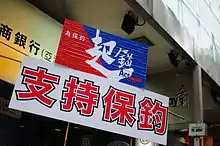Baodiao movement
Baodiao movement (Chinese: 保釣運動, literally Defend the Diaoyu Islands movement) is a social movement in Mainland China, Hong Kong and Taiwan that asserts Chinese sovereignty over the Diaoyu/Senkaku Islands.[1][2] The territorial right to the islands is disputed among the People's Republic of China, the Republic of China, and Japan. Action Committee for Defending the Diaoyu Islands and China Federation for Defending the Diaoyu Islands are the main representative organizations in the movement.

Political context
The Diaoyu/Senkaku Island are located northeast of Taiwan and southwest of Okinawa in the East China Sea. Administratively, they depend on the city of Ishigaki, on the island of the same name, in Okinawa Prefecture. Geographically, they are a part of the Sakishima Islands archipelago - along with the Yaeyama Islands and Miyako Islands (further to the south) - and the larger Ryukyu Islands.
The islands have been claimed since the late 1960s by the Republic of China, which views them as part of the city of Toucheng in Yilan County, as well as by the People's Republic of China, which claims them as part of Taiwan province. Though put on hold between 1978 and 1996 following the signing of a Chinese-Japanese diplomatic accord, the conflict was re-ignited when the "Nihon Seinensha" (Federation of Japanese Youth), a movement attached to the major Yakuza group Sumiyoshi-kai, built a lighthouse on the northernmost Senkaku island.[3][4]
Events
- In 1972,the United States ends occupation of Okinawa and Diaoyu Islands, initiating Senkaku Islands dispute.[5]
- In 2004, Chinese activists from the Baodiao movement movement landed on the islands and were arrested. Two days letter, Japanese prime minister Junichirō Koizumi demanded their return to China.
- In October 2007, Japan denounced the attempted landing of Chinese nationalist militants from the movement.
- On June 10, 2008, a Taiwanese fishing vessel and a boat from the Japan Coast Guard collided. The Taiwan Foreign Ministry recalled its representative in Tokyo to Taipei, and demanded apologies and compensation from Japan. A few days later, a nationalist boat escorted by nine Taiwanese military patrol boats came near Uotsuri-jima as a protest, before returning to Taiwan; Japan then called for both countries to "act calmly".[6]
- On September 25, 2012, 81 Taiwanese trawlers accompanied by a dozen Taiwan Coast Guard patrol boats patrolled off the Senkaku/Diaoyu Islands to defend the sovereignty of the Republic of China on the islands and Taiwan's fishing rights in the area.[7] The banners of the Baodiao movement were deployed on the trawlers. A clash occurred with the Japanese coast guard, who used water cannons on the Taiwanese vessels.[8]
Leadership
One of the prominent leaders of the Movement was David Chan Yuk-cheung. He drowned in the sea near the disputed islands during the first wave of direct protests. Tens of thousands of people from Hong Kong mourned his death in Victoria Park on Hong Kong Island.[9]
References
- "Disputes over Diaoyu Islands do Japan no good". China Daily. 14 September 2010.
- "Barren Senkaku Nationalism and China-Japan Conflict". Japan Focus. July 9, 2012.
- La Chine et ses frontières Sébastien Colin, Ed. Aemand Colin, 2011 (in French)
- Barren Senkaku Nationalism and China-Japan Conflict Wani Yukio, Japan Focus; 25 May 2012
- Tseng, Hui-Yi Katherine (2014). "The Taiwan Dilemma in the Diaoyu/Diaoyutai/Senkaku Islands Sovereignty Dispute". American Journal of Chinese Studies. JSTOR. 21: 111–126.
- Yoshida, Reiji. "Taiwanese patrol ships join intrusion". Japan Times.
- "81 trawlers in the Diaoyutai area Archived 2016-03-03 at the Wayback Machine", Taiwan Info, September 25, 2012
- "380005 大規模 保釣 總統: 堂堂正正 護漁 ", Radio Taiwan International, September 25, 2012 (in Chinese)
- "Thousands Mourn Drowned Protester". Chicago Tribune. September 30, 1996.